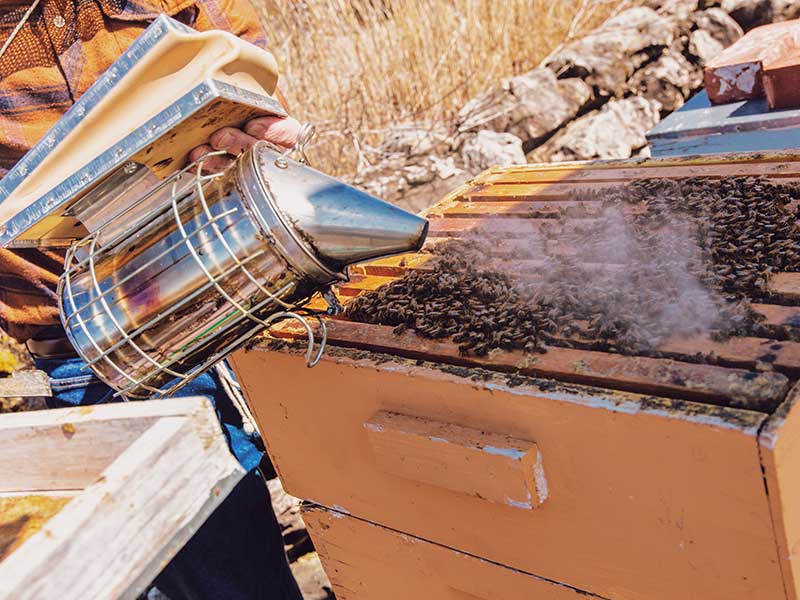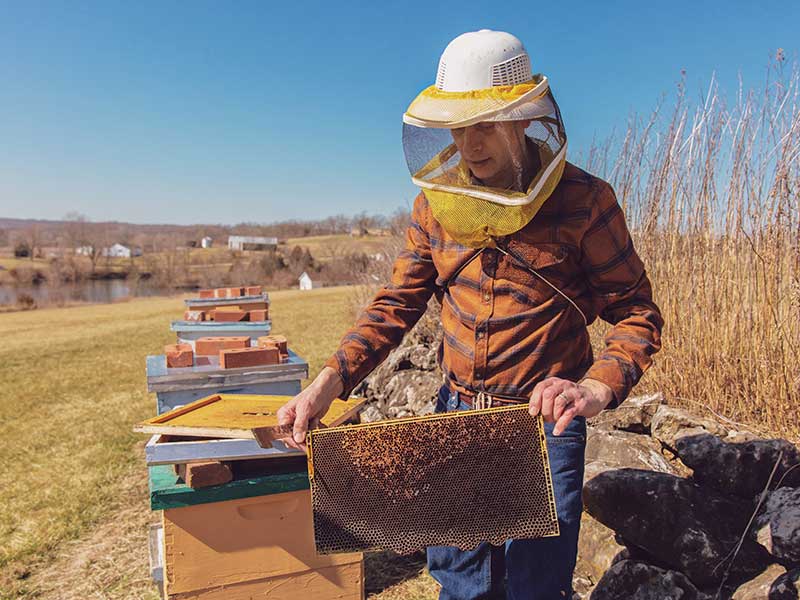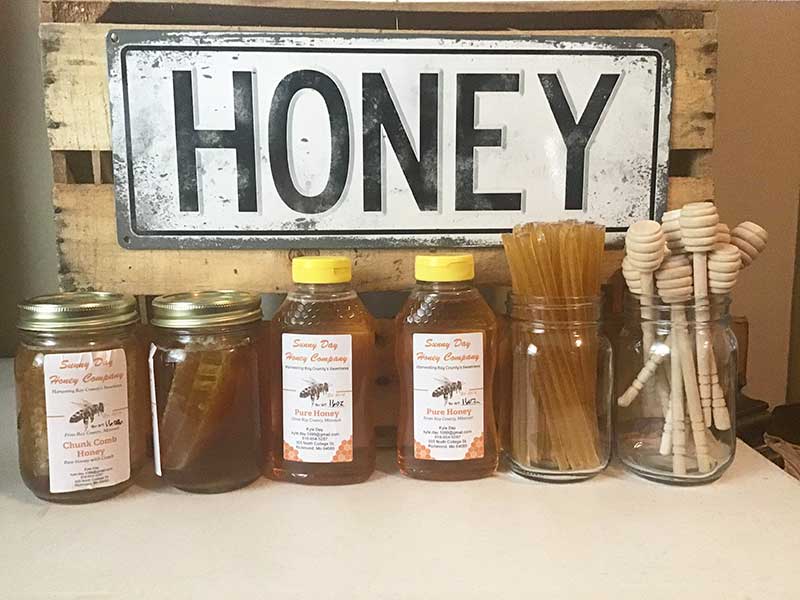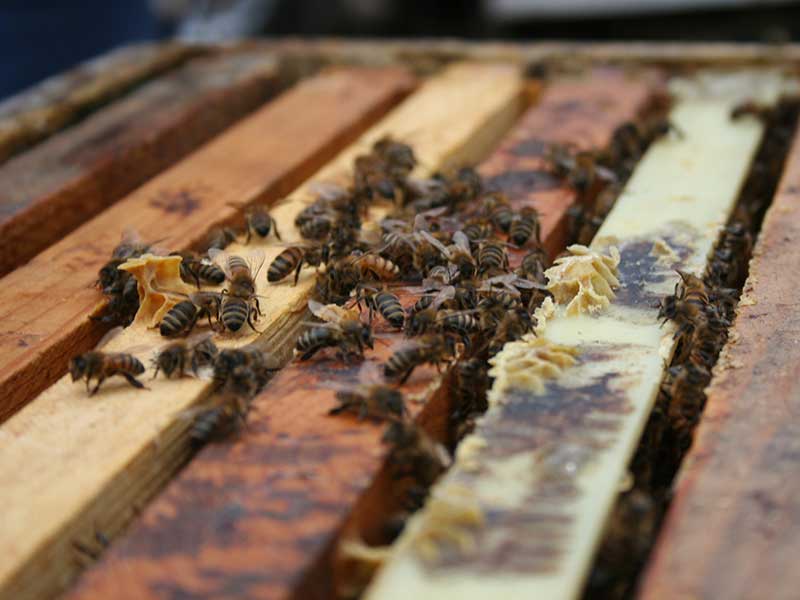Yes, beekeepers tend to get stung, though not often, and yes, they get used to it. Sort of.
“The whole stinging part was kind of overwhelming at first. But after a while, you kind of get used to it,” says Kyle Day, the former Missouri State Honeybee Ambassador. At Sunny Day Beekeeping in Richmond, about forty-five miles northeast of Kansas City, Kyle Day’s attention is more focused on watching the buzzing insects do their thing: using beeswax to make intricate honeycombs, then turning nectar into the sweet, sticky honey that packs the honeycombs.
“It’s just really fascinating to watch them work and how they communicate with each other,” he says. “It’s like a work of art.”
But those stings?
Kyle recalls one time when the stings were especially “uncomfortable.” One sting on his leg led to about forty more fifteen minutes later. The bees release pheromones with each sting, signaling other bees to join in. And depending on the time of year, the weather, or nectar flow, honeybees can be more aggressive.
“They can sting through the suits, but it’s less likely,” says Kyle, who sells honeybee products—honey and honeycomb—as well as supplies, including the familiar white beekeeper protective clothing, “basically everything you need to get started in beekeeping.” As unpleasant as a sting can be, it’s worse for the honeybee. Because the stinger is barbed like a fishhook, the bee pulls away some of its organs in the sting—and then dies after the act of aggression.
Stings are a hazard of the occupation, but the total number of bees in a hive provide an important perspective. At its peak of production in the summer, one hive can have between 50,000 to 75,000 honeybees.
The stinging question is “always the first thing” Eugene Makovec is asked at community events. As editor of the American Bee Journal, the oldest English language beekeeping publication in the world, Eugene is accustomed to answering it. He figures he’s been stung an average of 20 to 25 times a year—he keeps track—and with 25 years of beekeeping experience, that amounts to some 600 stings.
“If I get stung, it’s my own fault,” Eugene says. “I’m doing something” that provokes a defensive response or “I’m not wearing gloves most of the time.” He has 14 colonies of honeybees in Foley, on the western edge of the St. Louis metropolitan area. Eugene considers his hives a small-scale hobby operation, which is the category that best describes most of the Show-Me State’s beekeepers and honey producers.

Helpful Hobbyists
Kyle Day had 25 colonies or beehives in 2019, and he’s hoping to expand to 50 this spring, putting him into the “sideliner” beekeeping category. Honey producers with 500 or more beehives are considered commercial operations. Only a few dozen of Missouri’s honey producers fit that class.
“Most beekeepers are hobbyists,” Eugene says. “But most bees are owned by commercial producers.”
The US Department of Agriculture reported in 2017 that Missouri had roughly 8,000 producing colonies of honeybees, at 62 pounds of honey per colony for a total of around 496,000 pounds. In 2007, the Missouri total was around 7,000 colonies.
Most of the nation’s colonies are in California (2.1 million per USDA’s 2017 report), and Florida and Texas, with more than 200,000 colonies each. Every other state is far distant on the list.
Kyle and Eugene not only represent the east and west sides of the state, but also different age demographics. Eugene is 59. Kyle, who started beekeeping as an FFA project in 2014, is 20. He is a student at the University of Central Missouri in Warrensburg and hopes to be a teacher and FFA advisor after graduating. As a former honeybee ambassador, he traveled the state, and today, he still spreads information about bees.
The state’s bee and honey industry is growing, Kyle says. “We’re seeing more and more new beekeepers each year.” By some counts, he says, as many as 80 percent of each year’s new beekeepers will call it quits in the first two years. The main key, he says, is to be cautious about growing too rapidly. A hive generally needs a year before producing a substantial amount of marketable honey.
The initial investment for beekeeping is not cost prohibitive. Between $500 to $1,000 can get a keeper started with two hives, the necessary equipment, and the bees. The return on investment might not begin until year two, but at around $10 per pound for honey on the retail market, and from 100 to 200 pounds per hive, “that’s pretty decent profit,” Kyle says. “Each area has its own niche market. Anyone can be a profitable beekeeper,” he adds.
Scary Varroa Destructor
Though they politely answer questions about honeybees’ stinging ability and frequency of stings, both Kyle and Eugene prefer to turn the attention to a more pressing honeybee topic: the Varroa mite that caused a mysterious and precipitous decline in honeybee numbers from about the mid-1980s to around 2015. The peak decline was in the early 2000s. The scientific name certainly is ominous—Varroa destructor—but it’s not quite as bad as some media reports have suggested, Eugene explains.
“People ask, ‘What’s going on with the bees?’ A lot of people think honeybees are endangered, that they’re in trouble,” he adds. But the number of managed hives in the United States is about 2.9 million, up from
2.3 million just 10 years ago. Honeybees are not disappearing.
Beekeepers lose between 20 to 30 percent of their bees each year due to weather, disease, and other factors. On the plus side, beekeepers can split larger colonies to keep bees from swarming to form rogue hives elsewhere, thus creating new hives to make up for the loss.
“I can build back up to where they’re more than I need,” Eugene adds, summing up that “some degree of hive loss is a routine part of our life.”
Drones, Workers, and the Queen

Each hive has only one queen. The queen can live for three to five years but mates during one time period, early in her life, with several male or drone bees, and will remain fertile for life, laying up to 2,000 eggs per day. Fertilized eggs become female or worker bees, and unfertilized eggs become the male drones. When the queen dies or becomes unproductive, the other bees will “make” a new queen by selecting a young larva and feeding it a special diet of “royal jelly” that differs from the regular brood food worker bees eat. To make a queen takes 16 days.
A worker bee dies as a result of stinging, and the drone dies as a result of reproduction with a queen. Drones account for 5 to 10 percent of the hive population, and those that are still around in the fall are sent packing by worker bees—perhaps nature’s most dramatic demonstration of female power? The drones, without protection or honey to eat, soon die.
Just 21 days after emerging from eggs, worker bees carry on specific chores, from nursemaid and construction worker to undertaker and guard. Then 21 days later, halfway through her life cycle, the worker bee becomes a forager, collecting pollen and nectar that becomes honey.
What’s the Buzz?
- The female worker bee will live from 6 to 8 weeks and produce 1/12 of a teaspoon of honey in her lifetime, so lick the spoon!
- It takes 2 million flower visits and 55,000 miles of flying for the bees to make just 1 pound of honey.
- Cave paintings that have been found in Spain from 7,000 bc are the earliest records of beekeeping.
- Romans used honey, instead of gold, to pay taxes.
- Ancient Chinese completely covered smallpox sufferers with honey to speed healing and prevent scarring.
- Honey is antimicrobial due to its high sugar content, low pH, and the presence of organic acids, and some people still use it today as a natural treatment for cuts, scrapes, and burns as well as to prevent scarring.
- The venom from honeybees is used to treat a multitude of body ailments from cancer to multiple sclerosis.
- A honeybee’s top flight speed is 15 miles per hour.
- There are more than 300 different varieties of honey produced in the United States, each having its own distinct color and flavor. The different floral sources from which the honeybees gather nectar determine the characteristics of honey.
- Honeybees don’t hibernate. They cluster together and flap their wings to create heat, maintaining a 93-degree space. And they need plenty of honey reserved for them to make it through the winter.
(Sources: MissouriHoney.com; USDA Bee Lab webpage; University of Missouri Extension)
A Big Misconception

“One of the big misconceptions is that pesticides are our biggest problem,” he says. “They certainly are an issue, but the newest ones are developed to be safer for humans and for important insects. They’re closely targeted to the plant rather than being broadcast and hitting a lot of non-target insects,” Eugene says.
He also says it’s not fair to blame commercial honey operations for “stressing the bees” and causing colony decline, which usually occurs at the end of summer.
“The individual workers only live six to eight weeks in the summertime,” he explains. “They’re not living through the summer anyway.”
The big problem is the Varroa mite, which attaches to and feeds off honeybees. The mites can only reproduce in a colony. If undetected and untreated, they kill the bees and endanger the entire colony.
“It affects everybody,” from a hobbyist with one hive to large commercial operations and the wild honeybee population, says Henry County University of Missouri Extension Agronomist Travis Harper. Until recently, the general assumption was that the mite affects feral bees as much as managed or commercial bees, but that thinking is changing.
“There’s a thought out there that these feral bees have developed a natural resistance to the Varroa mite,” Travis explains. “There’s a pretty big movement of people who would rather capture feral swarms” for new hives instead of purchasing new swarms.
New chemical or synthetic treatments can kill the Varroa mite, and honeybee species have been developed with built-in resistance to the killer mite.
Kyle has two kinds of the “Varroa hygienic” breeds, as well as a Minnesota breed and Italian honeybees, the species most common among beekeepers. Russian breeds are popular, too.
Other Threats
There are other pathogens and diseases, too, and pesticides, but the decline has lessened. Colony Collapse Disorder (CCD) is another syndrome in decline for a few years now. Identified in 2006, it results in a dead colony with no adult bees and no dead bee bodies, but with a live queen and usually honey and immature bees still present. CCD tends to be more prevalent in commercial operations where hundreds or thousands of hives may be in proximity.
Travis says there appears to be less CCD in feral or wild bee populations, but “it’s hard to say for sure, because we don’t have as good tracking information on wild bees.” Travis, also a hobbyist beekeeper, teaches beginning beekeeping for MU Extension.
Honey Markets

There’s wide disparity in opinions among beekeepers over which breeds produce the best honey, but the key, in Kyle’s experience, is location, depending on what’s flowering and which species are pollinating. City locations can produce good quality honey if there are gardens nearby. Rural areas near soybean crops may produce exceptional quality and quantities of a light-colored sweet honey. Fall buckwheat will lead to darker, somewhat bitter honey production.
Some types of honey are supposedly good for people with allergies. Some are better for baking.
“There’s always a big market for local honey,” Eugene says. He sells most of his honey to local stores and regular customers. “We put it on everything. Anything you’d put syrup on, we put honey on it.”
In addition to providing bees for pollination, some producers also specialize in selling queen bees or selling “infused” honey—flavored honey, basically.
“The good news,” Eugene says, “is that honeybees and beekeepers are appreciated now like they weren’t a couple decades ago.
“A lot more people understand how important bees are for pollination service,” he explains.
Learning Opportunities
When Eugene’s local association in St. Peters began teaching classes and a beginner’s workshop, it attracted 50 to 60 per class at the start. The program still attracts around 35 newbies each time it’s offered.
In addition to being editor of the American Bee Journal, Eugene previously served 11 years on the Missouri State Beekeeper’s Association board.
The Journal has a unique connection to beekeeping history. One of the publication’s first writers, Rev. Lorenzo Langstroth, came up with a new beehive invention in 1851. The multi-frame beehive is still in use today. Removing honeycomb frames and replacing them without destroying the hive made the advent of commercial beekeeping possible. It also led to the best way to overwinter bees.
The Honey Bill

Weather, destructive pests and parasites, and now “fake honey” that is diluted or honey containing questionable added sugars—imported from other countries—have presented difficult challenges. But regulations, whether local zoning codes or health regulations, have also been battles.
The Honey Bill, also known as Senate Bill 500, passed in 2015, loosening regulations for small producers. Under the previous law, honey was held to the same regulatory standards as jams and jellies, and in order to sell wholesale through stores or other vendors, the beekeeper was required to have a certified commercial kitchen for extracting and bottling the honey. The law was changed to raise the sales threshold for honey to $50,000, allowing more beekeepers in the state to sell through their local stores, although some counties and cities may have different local regulations.
“If the purpose of the requirement was to avoid bacterial infection, that doesn’t make sense,” Eugene adds, because “bacteria can’t even live in honey.”
What You Can Do
Eugene wants to spread the word about what the public can do for honeybees and beekeepers. “You can stop killing all the wildflowers in your own yard,” he says, citing dandelions, clovers, and violets as among the plants that are important to pollinators. His concern for flying insects extends beyond bees, too.
“The honeybees don’t need saving. But if you want to do something to help, plant milkweed for the monarchs,” he says. “They are in trouble.”
You can also buy honey. Put it on your oatmeal.
Want to Become a Beekeeper?
First, check your local city and county zoning codes. If you’re in a homeowner’s association, check its rules, too.
If you have a green light, the Missouri State Beekeepers Association is a real—ahem—honey hole of information for connecting with beekeeping suppliers and locating honey to buy. Find a local beekeepers club—there are about 50 in the state—in addition to attending state conferences and similar events or meetings.
“It’s an addiction,” says Eugene Makovec, who keeps bees in a St. Louis metropolitan area. “What does your spouse think about it? Your neighbors?” Depending on where you live, you can probably have a half dozen hives far enough from a neighbor’s property line that he or she won’t object to a small, next-door apiary. “Of course, it certainly helps to take them a bottle of honey every now and then,” he adds.
Related Posts
Recipe: Loaded Sweet Potato (With Video Demonstration)
Learn how to make these baked sweet potatoes loaded with sweet chili glaze, filled with black beans, pickled carrots, and spring onions, plus video instructions.
Earthly Creations
They say that life is what happens while you’re busy making plans. We’re pretty sure you’d get no argument from Sandra Zak.

